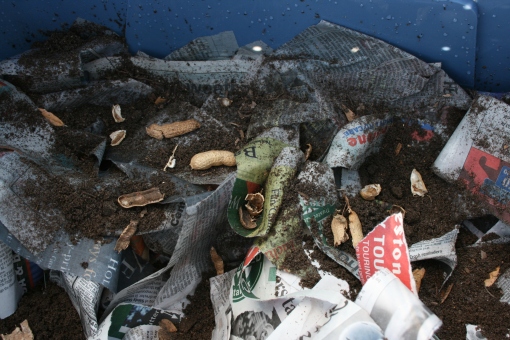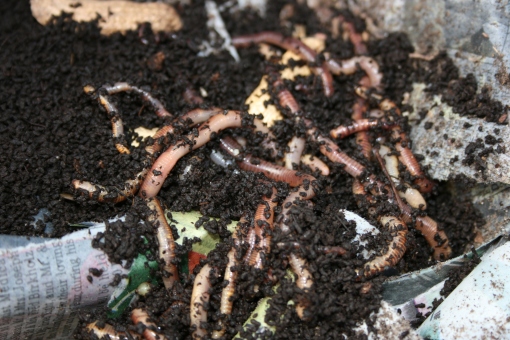The art of vermiculture. Yes, you heard it here first. We have begun worm composting!
Because we can’t wait until spring to get into garden mode, we’ve decided to get a jump-start — and what better way than with worms? Okay, my daughter would have something to say about this, but my son? He’s all for it! I mean, what boy doesn’t like worms? In fact, he treated me to a dissertation on the subject as we drove home from school. He and his young friends, it turns out, are well-versed in the subject. Found a mound of the wrigglys beneath an old tree on the playground.
Well, hold the cabbage! Did I hear you say you have worms at school? Then why aren’t they in the garden? These babies make the golden goose look like an ugly duck. *QUACK* We need worms and lots of them! Actually, we need their poop.
Loaded with nitrogen, worm poop (worm castings for you scientific types) is an excellent organic fertilizer. And I should know. The students at school threw handfuls of it in their garden when we first planted and I’m not ashamed to admit, their tomatoes and peppers completely outshone mine at home. Kids. Go figure. Next time I won’t be so quick to advise caution and restraint in the “worm poop throw” event.
So lesson learned (and what better place than among fellow students), I’ve decided an endeavor in the worm poop business would be a good idea. My garden needs all the help it can get frankly, and I’m open to suggestion. After a few clicks online, I found out how to make my own worm poop lodge. Rest comfy, my sweets, and eat to your heart’s content. The bathroom’s down the hall to the left. Don’t worry about the mess. I’ll get it. Wink, wink. (They have no idea what I’m up to, I’m sure of it!)
We bought the bin; your standard 78 qt. plastic variety. With the help of my husband, we drilled holes across the top, sides and bottom (about 1/16″ to 1/8″ should do — any bigger and your worms may find themselves an escape route!).
Then filled it with shredded newspaper, about 2/3 full. Next, we moistened the paper. Not too much. Apparently worms are finicky and like it damp, but not too damp. Think damp sponge. Roll of the eyes here. They remind me why I don’t have a cat, though I will indulge them. After all, I do have ulterior motives.
Fortunate enough to secure our worms (must be red worms or Eisenia foetida) from a local angler shop, run by an experienced angler, I was informed that worms like peanut hulls and eggshells, coffee grinds and banana peels. Wonderful! I just happen to have some old peanuts leftover from last summer. Eggshells?
Not on your life. Those are going to my tomatoes this spring. Coffee grinds and bananas are all theirs. Generous to a fault, aren’t I?
And since we want them to make healthy poop, we threw in a few old lettuce stalks from our fall garden. Adds to the “nitrogen” factor. (We’re always thinking!)
Then the worms. Rather than purchase the pound I originally intended, our new angler friend suggested I go with these two smaller containers. Seems worms multiply at alarming rates — not surprising when he explained that each worm comes equipped with both male and female attributes. Easy mixing.
He was also kind enough to show us the adult worm’s egg sack. Clearly identifiable on the upper body, this sack is supposed to “migrate” down toward the tail (do worms have tails?) and then off the body where the eggs “hatch.” He said we can expect as many as a 100 babies per adult! For those of you interested in full details, check out this link.
Quickly calculating the numbers in my head, I nodded. “You’re right. We’ll go with the two small tubs.”
My son did the honors. He is the resident expert on worms and all things fishing so it seemed a natural fit when gardens and fishing cross, right? Gently, he sprinkled them out into their new home. Aw…look at those little pumpkins. Aren’t they adorable?
In worm terms they’re cute. Amazingly beautiful, actually, when you consider their production capacity! And we are interested in production.
Can’t wait. In fact, we’ve checked on them three times already. Impatient bunch. A good thing we did, because we discovered a few had crawled up near the lid. On their way out?
Hope not. And I hope the holes don’t prove too big. Eagerly opening our bin to find no worms? That’ll be a sad day. Shudder the thought.












I love this entry. A worm bin has been on my list for a long time…. You’ve inspired me to get to work this weekend!
Just make sure they stay warm. I checked on mine the other night, and a few seemed to be rather still.
A little too still, if you ask me, but I’m holding on to the hope they will survive. Better than survive–I hope they reproduce like crazy!
Let the worm poo fly! Me and my daughter have had a blast with our worm composter. I’m in Ocala and don’t bring the composter inside and they have survived the freezes pretty well (and as you know the last two years have been pretty cold!)
I think ours are having a hard time adjusting — to the cold, their new home. A few seem immobile. I’m crossing my fingers they’re sleeping.
Great information everyone!
Can you tell me where you keep your worm bins? I live in the central-north-east zone and most days in the winter are below freezing and so is my garage for that matter. So, any suggestions as to where to keep this bin? Also, are all fishing worms, red worms? When I buy them from the local bait shops for my compost bin, the shopkeepers have no idea what I am talking about.
My worm bins are in the garage, but the important thing to keep in mind is they need to be kept at about 40 – 80 degrees. Perhaps you could place them by an exterior wall of your home for extra insulation and wrap their bin with a blanket?
And yes, most fishing worms should suffice. They are referred to as red worms, or “red wrigglys” around here! Here’s another great link for worm composting: http://www.redwormcomposting.com
Good luck!